Artist Interviews 2023
Kirsten Stingle 
By Julia Siedenburg
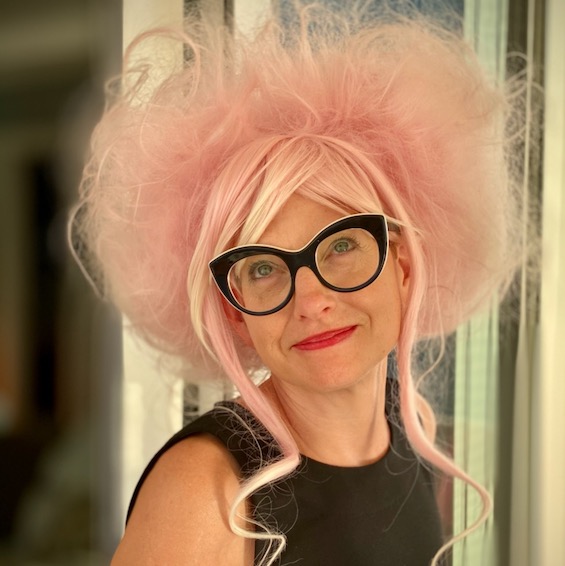
Kirsten Stingle is an artist that created beautifully haunting narrative sculptures. The women she creates remind me of some of our favorite fairytale characters growing up. Maybe a few showcase some rather eerie villainous details with them as well.
The attention to detail and the extreme care these sculptures have been crafted with are undeniable and that is what makes them so special. Every piece is more unique than the other as it tells its own story, part of its own world.
I couldn’t help but be completely captivated by her work when I was lucky enough to stumble upon it at the latest Los Angeles Art Fair. After I could not take my eyes off them for a whole long while I knew I had to get Kirsten to share a few insights with us and with you, our dear readers! So please enjoy our interview below and dive into Kirsten’s amazing mind with me.

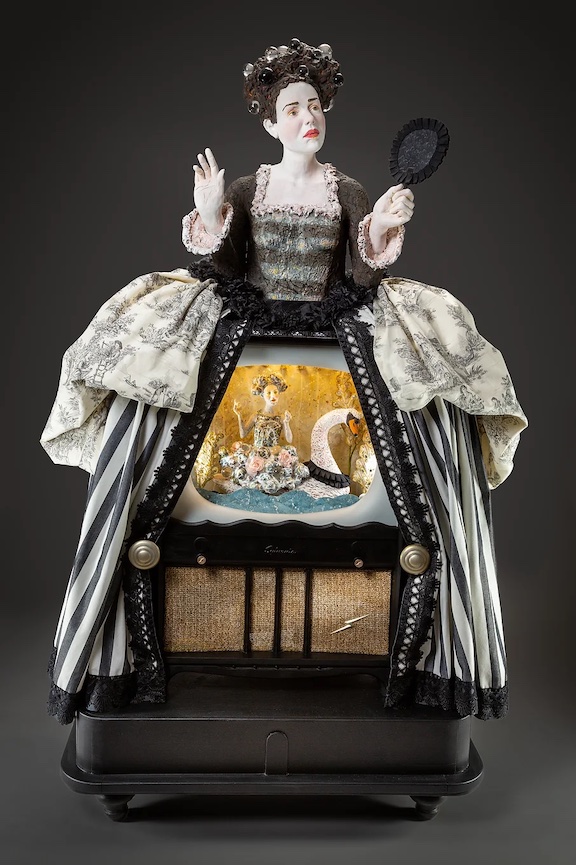
Your pieces are so beautifully crafted. These women remind me of characters from fairytales I used to love growing up. How do you choose the themes and stories that your sculptures portray and do you choose your colors for support?
In a way, that is exactly the kind of association I am trying to make. Stories are a uniquely human way of guiding our interactions with the world around us. Myths, folk tales, and fairytales are a way of learning about the complexity of our ecosystem and passing on that wisdom through the generations. Initially, these stories were oral and adapted to changing environments and times. The written word has, in many ways, ossified the power of these stories and today we have only scraps of relevancy. They are quaint tales that don’t speak to our current crises. Now we live in a world where we are globally connected yet struggle with feelings of isolation and disenchantment. It is easy to be overwhelmed by the social, political, and economic upheavals we are facing, not to mention the devastation of the climate crisis we seem to address only passively.
To your point, I am very much trying to create the world of enchantment and wonder that I felt as a little girl: full of beauty, mystery, and lurking shadows. Understanding and growth can be found by being attentive to the stories we share, and my work emphasizes the fantastical in order to tap into the mystery, empathy, and play in our world in an alluring way. What if we could drown out the binary, colonial production chatter of the dominant societal structures to focus on reigniting our curiosity in a more cooperative and intimate relationship with each other and our ecosystem? Can we find a way to collaborate and harmonize to better serve the vibrancy of life? These are the underlying questions of my work. My narrative world is fairytale-like in order to initiate a dialogue with the shadows and recognize the human condition of Modernity.
Color is an important element in translating the mood of the story. My recent collection explores a world in which nature is reweaving itself into the age of the Anthropocene. Like stumbling on an abandoned structure that is slowly being taken over with vines, moss gardens, and mold. As a result, I am incorporating more earth-based tones.
Regardless of the color palette, layering colors and mark-making are essential in my work. I want to express the complexity of humanity. Humans are like a palimpsest of our experiences, history, interactions, and relationships. That complexity needs to be recognized and celebrated.
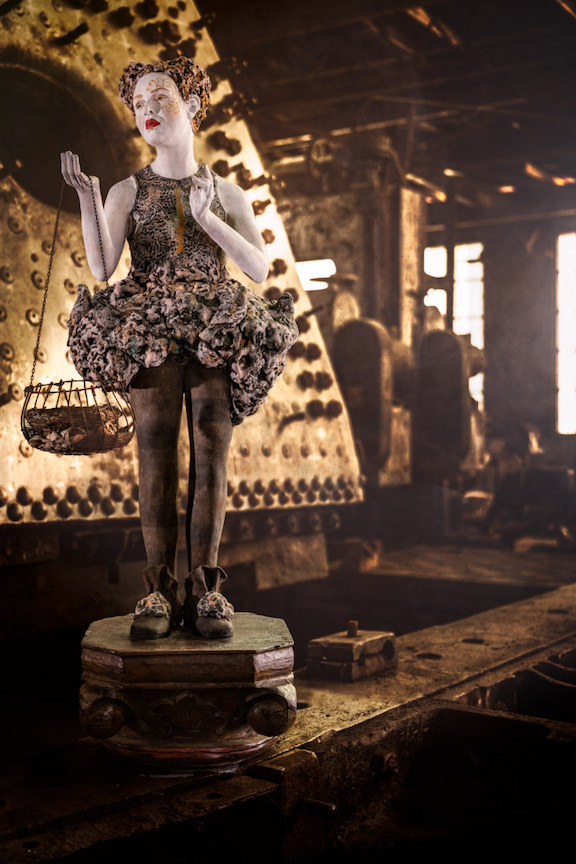
On your website, you describe yourself as a “narrative artist” who does not “want to create solitary objects, but rather manifest entire worlds of the imagination”. Please elaborate further for us.
As I said earlier, I consider myself a storyteller trying to express worlds and themes that might more easily be translated into the theater. I have a theater background and love the magic when the lights go down and the curtain rises: the rest of the world melts away and I am transported into another world. The challenge is translating that storytelling magic with an object. How can I enchant the viewer to stay within the narrative world of the sculpture and explore ideas? The very presentation of the sculpture, on a pedestal, creates a sense of isolation from work.
I understand this is to highlight the specialness of the object, but what I want to do is highlight the story, not the object in and of itself. To invite the viewer into the narrative, I layer my sculptures with as much narrative detail as possible. The richness of the world is one of the elements that entrance and transports the viewer. So too does the gesture and expression of the figures. Creating “monumental pieces” or installation works also allows the viewer to interact with the sculptures as equals and move in their space.
Another way I extend the narrative further is through collaboration. I have teamed up with Allison Parssi and Drew Stauss to photograph my works in abandoned settings. Usually, the sculpture is shot with a gray or black background to maximize focus on the piece. While this has the advantage of removing distractions, it makes my work feel static. Collaborating with photography in unique, otherworldly settings greatly extends the storytelling potential.
My greatest narrative collaboration was with a performing artist to create an immersive experience for the viewer. Three years ago I had the opportunity to collaborate with Italian actress and writer, Alessandra Mosca Amapola, on the “LIMBO” project. Using my sculptures as inspiration, she wrote a series of monologues exploring the landscapes of the mind through a female lens. We then performed the piece within a space using my sculptures as characters.
It was a 360-degree narrative experience using the stage, lighting, video, and sculpture to tell a story.
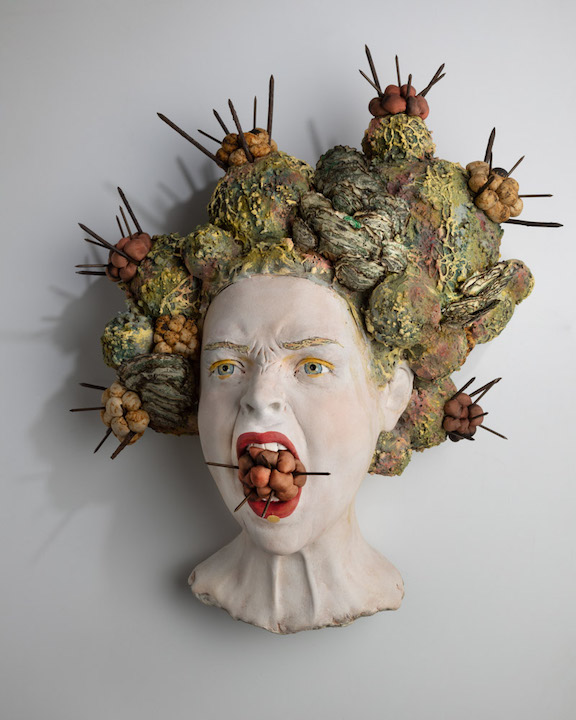
Your artwork is incredibly detailed. What and/or who inspires you personally?
I am very inspired by small handmade, detailed work that has become a lost art because we live in a time when so much is mass-produced, disposable, and meaningless. I love going to flea markets and looking for scraps of handmade lace, hand-beaded trim, or hand-mended fabric. The time and care embedded in these pieces are precisely what I like to incorporate into my work. Also, anything having to do with drama, theater, and costumes definitely makes me swoon.
For my current collection, I have been researching myths, legends, and folklore from around the world, as well as the ancient cultures and customs they represent. (I am really inspired by the writings of Sophie Strand, Natalie Haynes, and Sharon Blackie.) These authors have inspired me to look beyond the world I know and visualize humanity in a new way.
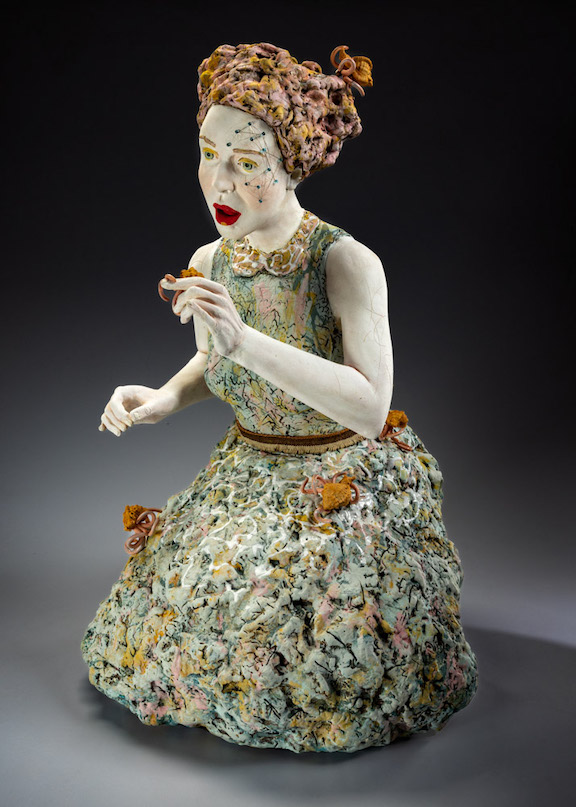
We would like to know a little more about your process. How long does it take from the idea to the final product and what are the steps you take to get the sculpture made?
When I first started out, my sculptures usually were inspired by found objects but that is not necessarily the case anymore. I trust the process and the themes I am exploring to reveal themselves, especially if I leave my rational mind out of it. I don’t do a lot of sketches before I build because the magic or energy feels diminished. I prefer to plunge headlong into the building and problem-solve along the way.
All my figures are hand-built porcelain stoneware (meaning I don’t use any molds) with ceramic finishes (kiln fired). I spend a lot of time focusing on gestures and expressions because they are the powerhouse of the story. For these fine details, my main tools are a scalpel and a straight pin. After the ceramic portion is finished, the figure must dry for up to two months. I don’t rush the drying process in order to reduce the possibility of cracking. After it is fired, I then apply ceramic finishes and fire it at least one more time. Once I am satisfied with the results, I start the mixed media portion. Then comes a much looser process—best described as really detailed, intense play—in which I combine antique relics with different mixed media techniques, such as stitching, encaustic, metalwork, eco-dying, etc. I use mixed media to unite the disparate sculptural components and add layers of detail to make the story lusher. This latter process usually takes a while because I am creating something new every time. I won’t repeat a specific piece, so translating emotions and themes through materials is different for each sculpture.
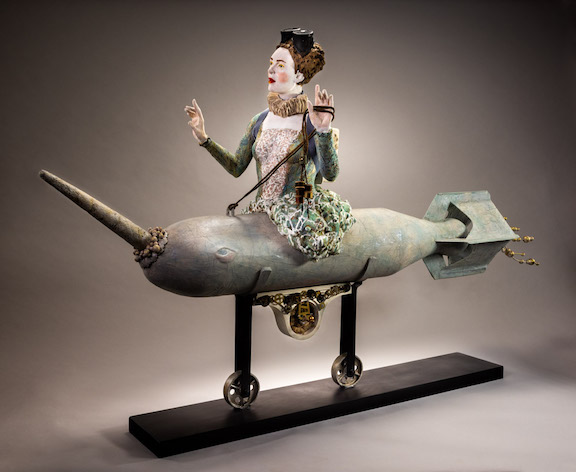
Please tell us a little bit about your childhood and upbringing.
I ran away once when I was three years old. I was at the mall with my mom and left to see Mary Poppins. I guess you could say that I have always been drawn like a magnet to the magic of storytelling and imagination. I grew up during a time when you were tossed out of the house in the morning to play and didn’t come home until dinner. We had a large, wooded area that ran along the back of our suburban neighborhood. It was full of creeks, moss beds, and decrepit barns. It was the perfect place to create fantastic games and dream the day away.
Growing up my mom would take us on local day trips that always included junk and antique stores. If it wasn’t expensive we were allowed to pick up a treasure to bring home. These objects didn’t hold great monetary value, but I was taught to appreciate the life and stories these objects and scraps represented. My dad grew up in a Wisconsin farming community in which nothing was ever thrown away if there was a possibility of it being reused or repurposed. So, if I wasn’t outside, I was in my “craft room” searching through his bits and bobs or things I had collected outside, such as a seed pod or snail shell, and creating miniature found object sculptures for my dollhouse or gifts. I loved—and still do—reimagining these forgotten pieces and creating something completely new. When I started sculpting in ceramics, antique scrap elements became a natural extension of my narrative voice. Antiques have great storytelling potential because they are pulsating with associations of the human and natural world.
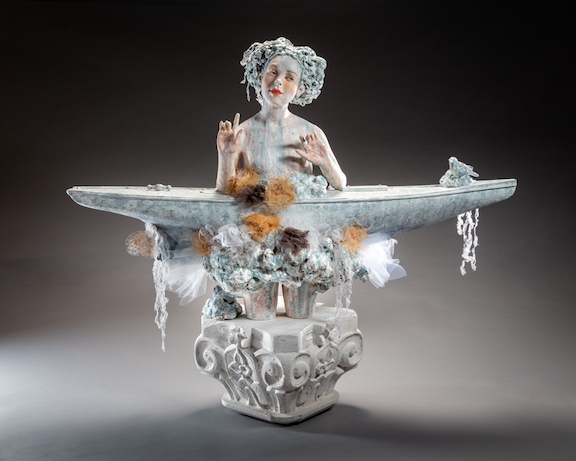
Your titles are very fitting to your storybook-like female figures. Do these titles come to you quickly and naturally or does it take some time to get them just right?
Thank you! I try to offer an insight or window into the narrative themes through the title, while at the same time being elusive enough to leave it open to the viewer’s interpretation. Titles can be similar to poems in their inspirational potential. Sometimes I have the title before I even create the piece, other times it is aggravatingly elusive. There have been pieces that have been renamed a few times trying to find just the right fit.
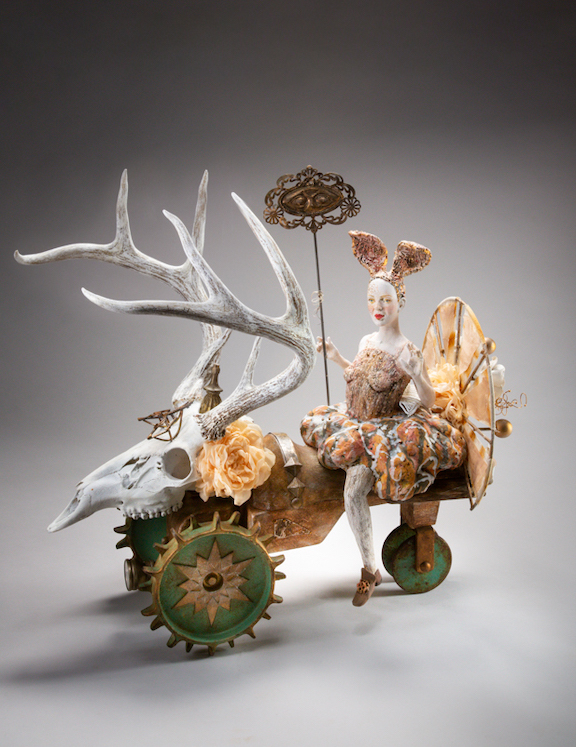
What stands out when looking at your Monumental Narratives are their faces and even more so their hair. Are these women modeled after people that you know or are they completely made up?
I don’t do representational work, rather, the figures I create are derived from my imagination.
At times, people have commented that some of the works resemble their maker. I don’t do this purposefully, but it makes sense because it is my face that I know best, and the stories I share are mine.
Artistically, I think of the hair and costume as another platform on which to layer narrative detail. My figures have big, burlesque, circus-like hair on which I can mount bubbles, scissors, or other items to decorate and add to the story.
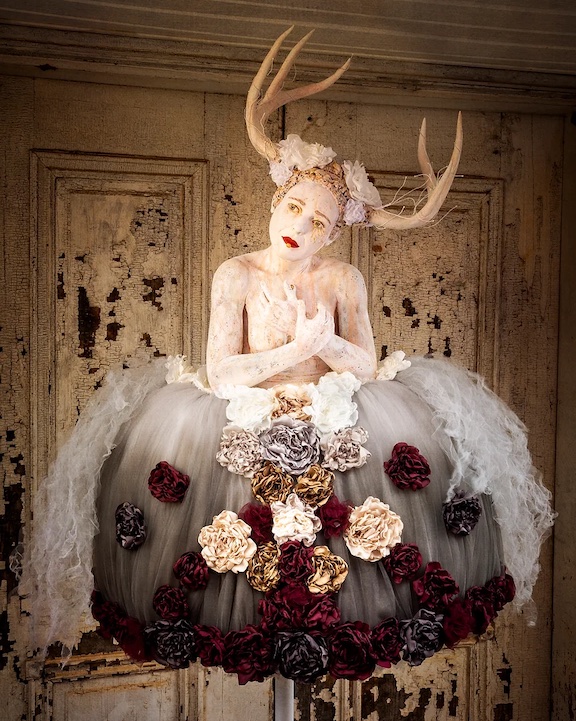
A lot of times artists are not only very creative in their being but also dress creatively. Your hair, very similar to your sculptures is seen styled mainly in a big round tower colored in a cotton-candy pink. Is the way you present yourself another way of letting your creativity flow?
Absolutely. During exhibitions, it is my inner drama queen’s time to shine! Because my work is an extension of my internal ponderings and yearnings, I like to reflect on my sculptures during an exhibition. It is fun and helps to break the ice. The first time I wore my cotton candy wig was on Halloween at SOFA. It was such a huge success and led to so many great discussions that I made it a permanent part of my exhibition style. And then, when the exhibit is over, I take it off to reveal my pixie-style haircut. There is a certain symmetry to going big at the show and then getting quiet to create in the studio.
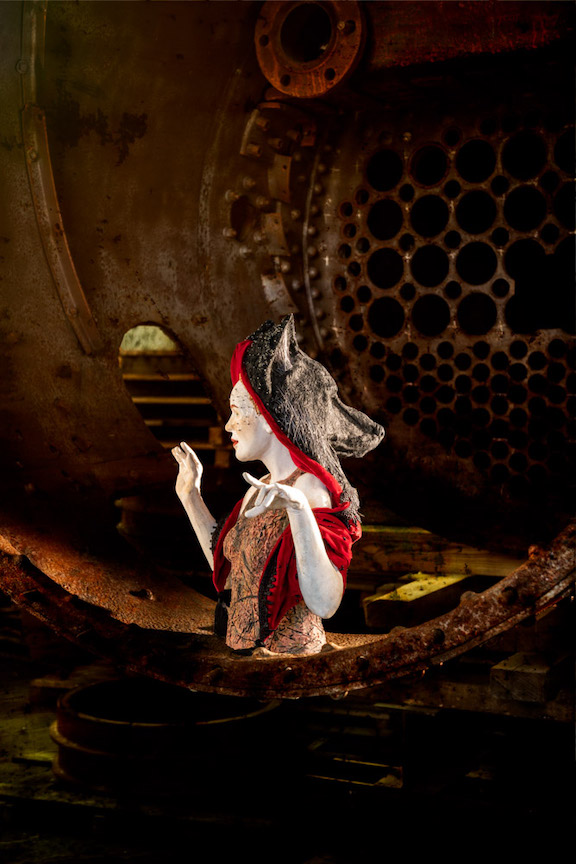
I was lucky enough to be able to see your work in person at the previous Los Angeles Art Fair. How did you get to showcase your work there and do you enjoy these types of art shows?
The LA Art Show was an amazing experience. The work at the exhibition was incredible and the people who attended were sophisticated and curious. It is such a joy to share my stories and process. Alone in the studio, I don’t have the opportunity to engage in a dialogue about the works with others. So, yes, I do enjoy these art shows. However, because my sculptures are personal and come from my yearning to connect, I sometimes struggle with the commodification aspect of the art world and fall into the pattern of equating value with sales. I find it best to find a balance between opportunities to exhibit and opportunities to create.
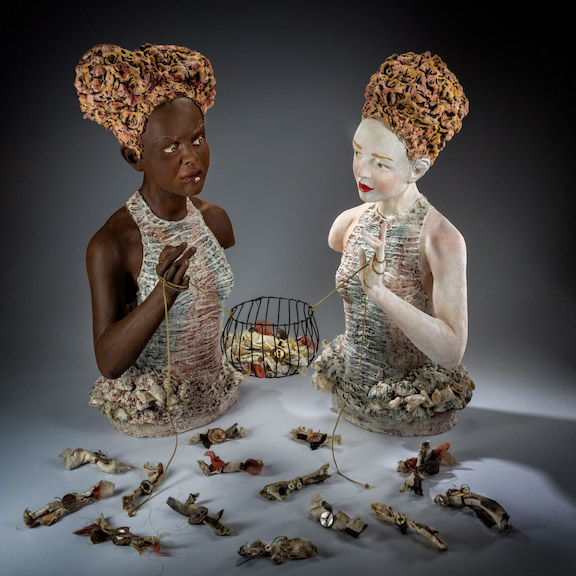
What’s next for you? What are your plans for the future?
The rest of the year is very exciting. From April 20-23 I will be in California again, exhibiting with OKAY SPARK at Art Market San Francisco. Later in the year, I am teaching several workshops, one of which is in Saint Raphael, France, rewilding myths in ceramics and mixed media. My classes are open to people of all levels, even those that have never touched clay. While in France, I will be able to attend the opening of “HEY! CERAMIQUE.S,” a year-long museum exhibition at the Museum of La Halle Saint Pierre in Montmartre, Paris, curated by Anne Richards, founder of “HEY! Modern Art and Pop Culture magazine.” Although my work has been exhibited several times in Rome, Italy, this will be the first time exhibiting my work in Paris and it is truly a dream come true. Then, I am also curating a three-month-long exhibition, “In. Visible,” at the Bascom Center for Visual Arts in Highlands, NC. It combines narrative painting and sculpture to revitalize stories that speak to our contemporary challenges. In 2024, I have workshops in Morocco and Ireland.
That being said, I am also grappling with the overwhelming push to constantly produce crashing against the fact that the well of authentic creativity needs time to refill. Consistently producing, staying “relevant,” and manifesting opportunities is exhausting and doesn’t necessarily nourish my creative imagination. I am trying to find balance and embrace the process of slowing down as equally valid. Whether that means listening to the water run over the rocks in a stream, visiting a museum, or daydreaming over a fire, these quiet moments are essential. Being driven is part of my identity and it isn’t easy for me to nurture the simmering moments outside the studio, but I am striving to be patient and flow.
|
|

